
Endangered Snowy Plovers Hatch New Hopes At SPCA Monterey County
In a heartwarming conservation success story, two baby snowy plovers have recently hatched at the SPCA Monterey County Wildlife Center. This event marks a pivotal moment for this threatened species, showcasing the impactful efforts of organizations dedicated to wildlife preservation.

The snowy plover, a small shorebird found along the Pacific coast, is classified as a threatened species under the Endangered Species Act. Its existence is challenged by a variety of environmental threats, including human disturbances at nesting sites, increased predation linked to urbanization, and looming climate change issues such as rising sea levels. These factors jeopardize their fragile nesting grounds, making every hatchling a significant milestone in their conservation story.
These two chicks were rescued and nurtured by Point Blue Conservation Science, a nonprofit organization that works tirelessly to mitigate environmental threats while fostering solutions that benefit both wildlife and human communities. The rescue and rehabilitation of these chicks underscore the vital role of such organizations in assuring the survival of endangered species.
Snowy plovers typically produce small nests and lay camouflaged eggs, making them particularly susceptible to predation and habitat destruction. With their natural breeding season spanning from March to September, awareness and protective actions from the community are crucial. It is vital for beach-goers to respect fenced-off nesting areas and refrain from bringing pets to these sensitive environments during this critical period.
The chicks at the SPCA Monterey County Wildlife Center will remain in care for up to a month before they are released back into their natural habitat. This period is essential for their growth and development, ensuring they have the best chance at survival once they re-enter the wild.
As we celebrate the hatching of these snowy plover chicks, it's a reminder of the broader challenges many endangered species face. What can you do to contribute to their preservation? Engaging with and supporting local conservation efforts, respecting natural habitats, and raising awareness can make a difference. Share your thoughts on how we can collectively aid these incredible creatures and other endangered species. Together, we can help secure a future where these birds thrive in their natural environments.